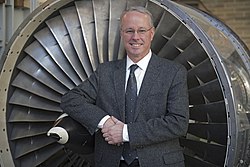Professor David W. Miller | |
|---|---|
 Dr. Dave Miller posing in front of an airplane engine | |
| Education | Massachusetts Institute of Technology |
| Engineering career | |
| Discipline | Aeronautics & Astronautics |
| Institutions | Massachusetts Institute of Technology NASA |
| Employer(s) | Jet Propulsion Laboratory |
| Projects | SPHERES |
David W. Miller is an American aerospace engineer who is the current Jerome Hunsaker Professor of Aeronautics and Astronautics at Massachusetts Institute of Technology and an elected Fellow of the American Institute of Aeronautics and Astronautics since 2015. [1] [2] [3] [4] He is currently on a leave of absence from MIT to be the Technologist for the Astronomy and Physics Directorate at NASA's Jet Propulsion Laboratory. Previously, he served three years as a VP and the Chief Technology Officer to The Aerospace Corporation. [5] He has worked on multiple NASA projects and served as NASA chief technologist at NASA headquarters in Washington, DC. [6]